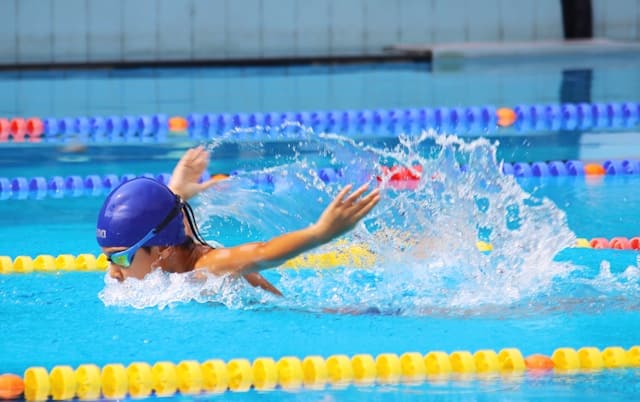Can Diaphragmatic Breathing Exercises Improve Performance in Competitive Swimmers?

Whether you’re a competitive swimmer striving for improved performance or a fitness enthusiast looking to enhance your endurance, diaphragmatic breathing exercises could be a game-changer. This article will delve into the scientific research and anecdotal evidence surrounding the impact of these exercises on swimming performance.
Understanding Diaphragmatic Breathing
Diaphragmatic breathing refers to a technique that involves deep inhalation through the nose, filling the lungs to maximum capacity, followed by slow exhalation from the mouth. This breathing method emphasizes the use of the diaphragm, a dome-shaped muscle at the base of the lungs, rather than relying solely on the chest muscles.
Dans le meme genre : What Strategies Aid in Reducing Digital Eye Strain for Remote Workers?
Several studies, accessible via scholarly search engines like Google Scholar or PubMed, have underscored the potential advantages of diaphragmatic breathing. These benefits include enhanced lung capacity, improved inspiratory muscle strength, and better control over one’s breath, particularly during strenuous exercises like swimming.
The Role of Breathing in Swimming
When it comes to swimming, breath control is paramount. The nature of the sport necessitates submerging in water, which inherently challenges our normal breathing patterns. Swimmers must learn to coordinate their strokes with their breathing, inhaling above water and exhaling underwater—a process that requires exceptional breath control.
Cela peut vous intéresser : Does Engaging with Interactive E-Books Enhance Learning in Children with Dyslexia?
Studies available on PubMed and Google Scholar have emphasized the importance of lung capacity and inspiratory muscle strength in swimmers. A high lung capacity allows for more oxygen intake, thereby delaying the onset of fatigue during swimming. Similarly, strong inspiratory muscles enable efficient inhalation, promoting optimal oxygen supply to the muscles.
Diaphragmatic Breathing Training and Swimming Performance
Some swimmers have reported noticeable improvements in their performance after incorporating diaphragmatic breathing exercises into their training regimen. However, anecdotal evidence is not enough. It’s crucial to delve into scientific findings to substantiate these claims.
In one study, published in PubMed, participants underwent an 11-week inspiratory muscle training program that included diaphragmatic breathing exercises. The results indicated a significant improvement in the participants’ swimming performance, suggesting a link between diaphragmatic breathing training and enhanced swimming capabilities.
Using Technology to Aid Diaphragmatic Breathing Training
With advancements in technology, there are now devices available that can assist with diaphragmatic breathing training. One such device is Airofit, which provides live feedback on your breathing and offers personalized training programs.
Airofit has also been subject to scientific scrutiny. A trial involving swimmers as participants indicated improved inspiratory muscle strength and lung capacity following the use of Airofit. These improvements were accompanied by enhanced swimming performance, strengthening the case for diaphragmatic breathing training.
Putting It All Together
While diaphragmatic breathing training holds promise for improving swimming performance, it is not a one-size-fits-all solution. Factors such as individual health conditions, athletic background, and training intensity will influence the effectiveness of this technique.
Therefore, it is recommended to incorporate diaphragmatic breathing exercises into your routine under the guidance of a qualified professional. They can help tailor a program that best suits your needs and monitor your progress.
Remember, while optimal breathing can enhance your performance, it is only one piece of the puzzle. Consistent training, balanced nutrition, and adequate rest are also crucial for achieving peak performance.
Although the evidence supporting diaphragmatic breathing training is growing, more research is needed to fully understand its potential. Nonetheless, the current findings suggest that swimmers might find it worth their while to explore diaphragmatic breathing exercises as part of their training.
The Science Behind Diaphragmatic Breathing and Swimming Performance
We’ve established the key role of breath control, lung capacity, and inspiratory muscle strength in swimming. Now, it’s time to dig deeper into the science behind diaphragmatic breathing and its influence on swimming performance.
In a study published in the European Journal of Applied Physiology (Eur Appl Physiol), scientists conducted an 11-week program of inspiratory muscle training, which included diaphragmatic breathing exercises, with a control group of swimmers. They found that the swimmers who completed the program demonstrated significantly improved inspiratory muscle strength and lung function compared to a control group.
Another study observed elite swimmers over a similar training period incorporating diaphragmatic breathing exercises. The swimmers reported not only enhanced lung capacity but also improved breath holding ability, a key skill in swimming.
A different research conducted by the same journal (Eur Appl Physiol) focused on the impact of diaphragmatic breathing on the synchronization of swimming strokes and breath control. The results suggested that swimmers who practiced diaphragmatic breathing managed to achieve a better rhythm between their strokes and breaths, ultimately enhancing their swimming performance.
Despite the positive results, it’s important to note that the studies were small and more extensive research is needed. Nonetheless, these findings suggest a promising correlation between diaphragmatic breathing exercises and improved swimming performance.
Conclusion: The Future of Diaphragmatic Breathing in Swimming Training
To sum up, diaphragmatic breathing exercises have the potential to revolutionize how we approach swim lessons and training programs. The technique, which emphasizes the use of the diaphragm for breath control, has been linked to increased lung capacity and inspiratory muscle strength. These factors play a crucial role in swimming performance.
Devices like Airofit are leading the technology-assisted push towards incorporating diaphragmatic breathing into training regimens. By providing real-time feedback and personalized training programs, they make diaphragmatic breathing exercises more accessible and efficient.
However, it’s crucial to remember that perfecting a breathing technique is not a quick fix for immediate results. Consistent training, balanced nutrition, and sufficient rest are just as essential for high-level performance. Moreover, diaphragmatic breathing exercises should be implemented under the supervision of a qualified professional to ensure they are done correctly.
As we move forward, more research is needed to fully comprehend the potential of diaphragmatic breathing exercises in swimming performance. Yet, the current evidence suggests that this technique could be a valuable addition to the training regimen of both competitive and recreational swimmers.
